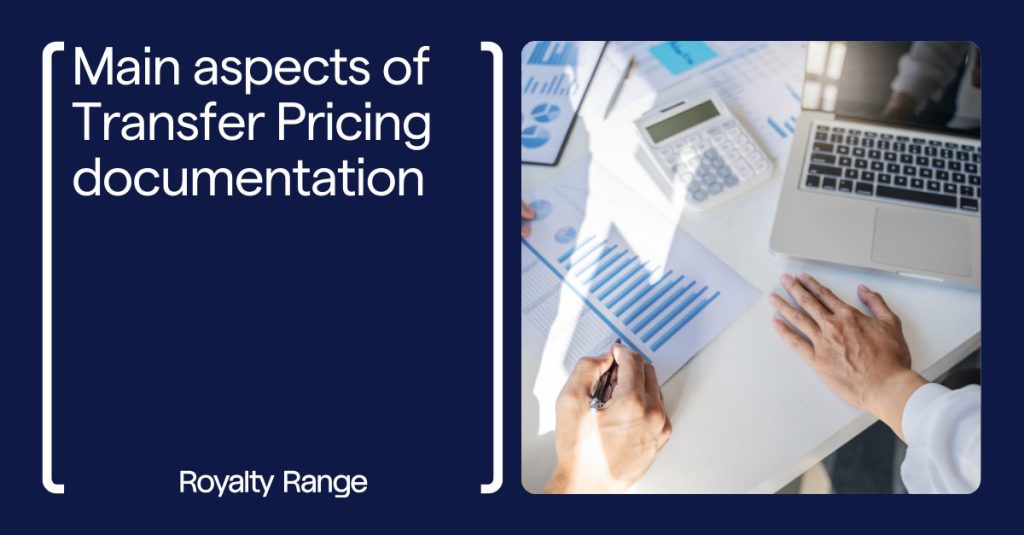Main Aspects of Transfer Pricing Documentation
RoyaltyRange

Transfer Pricing documentation gathers details about transactions between companies within the same corporate group, and dealings between a company and its permanent establishments. Its primary purpose is to demonstrate that transfer prices follow the arm’s length principle, ensuring that the pricing in related party transactions mirrors what would have been charged if the parties were independent.
Transfer Pricing documentation varies from country to country, even among the OECD member states. While the OECD Guidelines, particularly Chapter V, serve as the foundation for Transfer Pricing documentation, they provide a comprehensive and wide-ranging review. This extensive scope has contributed to the differences in how Transfer Pricing documentation is approached across the EU, leading to a lack of uniformity in requirements. There are two different angles for understanding Transfer Pricing documentation:
- On one hand, a major point of dispute lies in the differing perspectives between businesses and tax authorities regarding the need for Transfer Pricing documentation, its content, and the timing of its preparation. These disagreements stem from the differing priorities of each party. For tax authorities, the main objective is to safeguard the local tax base, with Transfer Pricing being essential in this effort. They expect businesses to follow the arm’s length principle and provide supporting documentation demonstrating compliance.
- On the other hand, businesses primarily focus on the uncertainty around the risk of double taxation and the significant compliance burden that Transfer Pricing documentation often brings. While they strive to comply with the Transfer Pricing rules and have their tax returns approved by auditors with minimal difficulty, the business community feels that discussions about documentation requirements are pointless without effective measures to prevent prolonged cases of double taxation.
Compiling Transfer Pricing documentation helps international companies avoid potential misunderstandings or adjustments during tax audits conducted by authorities in various countries. By preparing thorough documentation for each fiscal year, companies can reduce the likelihood of later adjustments, minimizing the risk of international double taxation.
Moreover, such documentation helps companies identify relevant related party transactions and make well-informed decisions about Transfer Pricing. It can also improve the company’s understanding of its intra-group transactions and the associated functions. Carefully updating Transfer Pricing documentation is advisable at least annually, because it allows companies to access current information on transactions, which can be useful in real-time decision-making. Waiting too long may result in difficulties recalling the specific details of individual transactions or decisions later. In years when no major changes occur in the company’s operations, updating the documentation may only require revising key figures.
Even if a company is not legally required to prepare full documentation under the Act on Assessment Procedure, multinational enterprises are encouraged to document their related party transactions, even in an informal way. Having well-organized records can be useful if full documentation is later required or if the company needs to discuss its Transfer Pricing practices with tax authorities.
A good Transfer Pricing documentation should be comprehensive enough that someone unfamiliar with the company could easily understand how the business operates, how functions are carried out, what assets are used, and how risks are shared between related parties in each transaction. The document should clearly outline the parties involved, the different payments and responsibilities, the conditions of the transactions, and the objectives behind them.
The documentation process is often shaped by the practices and preferences of the group’s parent company. However, there are some common steps that companies can take to streamline the process:
- Centralize as much of the documentation process as possible. This could involve preparing materials that cover the group as a whole, analyzing consolidated group accounts, and collecting intercompany agreements.
- When preparing the documentation, focus on key countries and transaction types, and dive deeper into specific areas when time allows. It’s important to keep the functional analysis consistent across different countries, as trying to perform a detailed review for every individual jurisdiction can quickly become overwhelming.
- Experienced Transfer Pricing specialists should work closely with less experienced staff to ensure the accuracy and relevance of the documentation. This also facilitates knowledge transfer, ensuring the efficiency of future documentation processes.
- Where possible, build on prior experience and past work to avoid duplicating efforts. It is also helpful to centralize the review of any materials prepared locally to prevent misunderstandings and ensure consistency.
- Finally, aim to automate or streamline future compliance efforts where practical.
By following these steps, over time, a company can develop a system enabling the efficient preparation of local country documentation using both central and local resources. While it may take several years to fully implement a global documentation system, the primary focus eventually shifts to ongoing maintenance.
Technology usage allows companies to save time and resources while enhancing the precision and dependability of their Transfer Pricing documentation. However, it is essential to choose and apply technological solutions tailored to the company’s unique needs and objectives.
If you need assistance finding the right comparables or selecting the appropriate method for your benchmarking analysis, consider exploring the solutions provided by RoyaltyRange here.
Sources:
https://taxation-customs.ec.europa.eu/document/download/235547f8-2066-433c-b314-fe5f0fca54e8_en